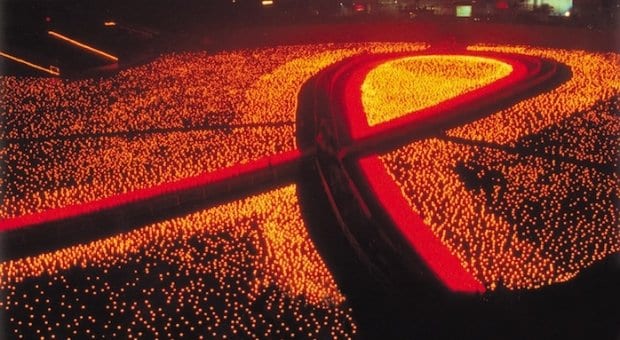The hot summer of 1990 saw the infamous police raid on the Sex Garage loft party in Old Montreal, which turned out to be Montreal’s Stonewall. The raid on the underground party led directly to the creation of the two gay festivals that put Montreal on the international gay map — Black & Blue in 1991 and Divers/Cité in 1993.
“Montreal definitely needed a breath of fresh air back then, especially the city’s gay nightclub scene, which was a bit lame at the time,” says Black & Blue founding president Robert Vezina.
Roughly 800 revellers attended the very first B&B — which was held in an abandoned bank branch on The Main in 1991 — and attendance peaked when B&B drew 17,000 at Olympic Stadium in 1999. But attendance declined to about 5,000 last year, when the event was held at the Palais des Congrès, so organizers Bad Boy Club Montreal (BBCM) are moving the 23rd edition to The Arsenal, in Griffintown, where they hope to draw 3,000 partygoers to their main event on Oct 13.
“We want to recreate that edge we used to have back in the mid-’90s,” Vezina says. “Over the years, the costs kept going up, and the ticket price basically stayed the same. So we wanted to find a space that cost less than Olympic Stadium and the Palais des Congrès and was more flexible in terms of artistic content. When I walked into L’Arsenal for the first time, I had a eureka moment. The space really is gorgeous.”
The Arsenal served as a shipyard during the 19th century. Today, the converted 41,000-square-foot space showcases Canadian and international contemporary art and hosts special events.
Because Arsenal managers were reticent to host an all-night dance party, “we had to come up with a concept that combined the missions of The Arsenal and B&B,” Vezina says. “So we’re having a live art exhibition and auction. Over 40 artists will create new art onsite, and expect each artist to produce an average of two pieces each. People can bid on the works, and 50 percent of the proceeds will go to the artist and 50 percent goes to the BBCM Foundation.”
Since B&B’s first party raised $3,500 for AIDS Community Care Montreal in 1991, the BBCM Foundation has donated $1.8 million to various AIDS and LGBT organizations. But with festival costs climbing and main event attendance declining, donations are drying up. Last year, Vezina says, BBCM donated $5,000 after B&B “lost $50,000.”
“One of the key changes since 2011 is we no longer receive $100,000 from [Quebec’s] Fonds d’initiative et de rayonnement de la métropole (FIRM), which paid for all the big stuff,” says Vezina, who estimates this year’s budget at $300,000. “That’s why we moved to The Arsenal. Less capacity means less money. But if you have big capacity, your costs go up. We’d rather turn this into a trendy underground sell-out crowd and rebuild the brand.”
In addition to a full slate of international DJs spinning at B&B (notably headliners DJ Dennis Ferrer, of NYC, in the house room and Amsterdam’s DJ Richard Durand in the trance room), the week-long B&B festival also boasts a Jock Ball (Oct 10 at Club Unity), its annual Leather Ball (Oct 11 at Club Soda, until 8am), the Warehouse Party, in collaboration with the InterPride Montreal Conference (Oct 12 in the west section of The Arsenal, until 6am), and the official Recovery Party (Oct 14 at Club Apollon).
The theme for this year’s B&B main event (Oct 13 at L’Arsenal, until noon Oct 14) is The Reinvented Wheel. At 1am, the Cirque Éloize will perform an SM-flavoured show based on Saint Catherine of Alexandria, the martyr also known as Saint Catherine of the Wheel, who was condemned to death on a spiked breaking wheel after spurning the Roman emperor Maxentius. “She will roll through the crowd, from one end of the room to the other,” Vezina says. “It is also a wink at the fact that Montreal’s Gay Village is located on Ste Catherine Street.
“Circuit parties are changing in general, but to say that they are in decline is inaccurate,” Vezina adds. “It depends on the city and the event. Here at Black & Blue, we’ve decided we want a smaller but better-quality event, instead of a huge commercial product. Gays are fickle; they want quality, and we got the message.”
“That’s also why we’ve called this edition of Black & Blue ‘The Reinvented Wheel.’ We’ve really gone back to our roots this year. But the real star is The Arsenal itself. People will go ‘wow’ when they see the space.”
The 23rd annual edition of the Black & Blue festival runs Wed, Oct 9–Tues, Oct 15.
bbcm.org/home-en


 Why you can trust Xtra
Why you can trust Xtra


